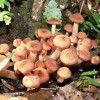Abstract
Armillaria root rot is a disease that decays the root system of many common trees and shrubs. It is caused by several species of Armillaria, fungi that can be recognized by the clusters of yellow to honey-colored mushrooms that emerge during moist conditions. The disease is often lethal, and infected trees may have wilting branches, branch dieback, and stunted growth. Infected trees and shrubs should be removed and replaced with resistant species. This 4-page fact sheet was written by Laura Sanagorski, Aaron Trulock, and Jason Smith, and published by the UF Department of Environmental Horticulture, July 2013.
References
Alfieri, S. A. Jr., K. R. Langdon, J. W. Kimbrough, N. E. El-Gholl, and C. Wehlburg. 1984. Index of Plant Diseases in Florida (Revised). Bulletin 14. Tallahassee: Florida Department of Agriculture and Consumer Services Division of Plant Industry.
Cox, K. D., H. Scherm, and T. G. Beckman. 2004. "Armillaria Root and Crown Rot." Southeastern Peach Growers Handbook. http://www.ent.uga.edu/peach/peachhbk/fungal/armillariacr.pdf.
Davidson, R. M., and R. S. Byther. 1994. Armillaria (Shoestring) Root Rot. Bulletin 1776. Pullman: Washington State University Extension. http://cru.cahe.wsu.edu/CEPublications/eb1776/eb1776.html.
Hagle, S. K. 2008. "Management Guide for Armillaria Root Disease." USDA-Forest Service Forest Health Protection Publication 11.1. http://www.fs.usda.gov/Internet/FSE_DOCUMENTS/stelprdb5187208.pdf.
Raabe, R. D. 2008. "Plants Resistant or Susceptible to Armillaria mellea, the Oak Root Fungus." University of California. http://mastergardeners.org/pdf/Armillarialist-2008-06-16.pdf.
Sinclair, W. A., and H. H. Lyon. 2005. Diseases of Trees and Shrubs. Ithaca, NY: Cornell Press.
Williams, R. E., C. G. Shaw III, P. M. Wargo, and W. H. Sites. 1986. Armillaria Root Disease. USDA-Forest Service. Forest Insect & Disease Leaflet 78.
Worrall, J. 2007. "Armillaria Root Disease." http://www.forestpathology.org/dis_arm.html.
Unless otherwise specified, articles published in the EDIS journal after January 1, 2024 are licensed under a Creative Commons Attribution-NonCommercial-NoDerivs 4.0 International (CC BY-NC-ND 4.0) license.

